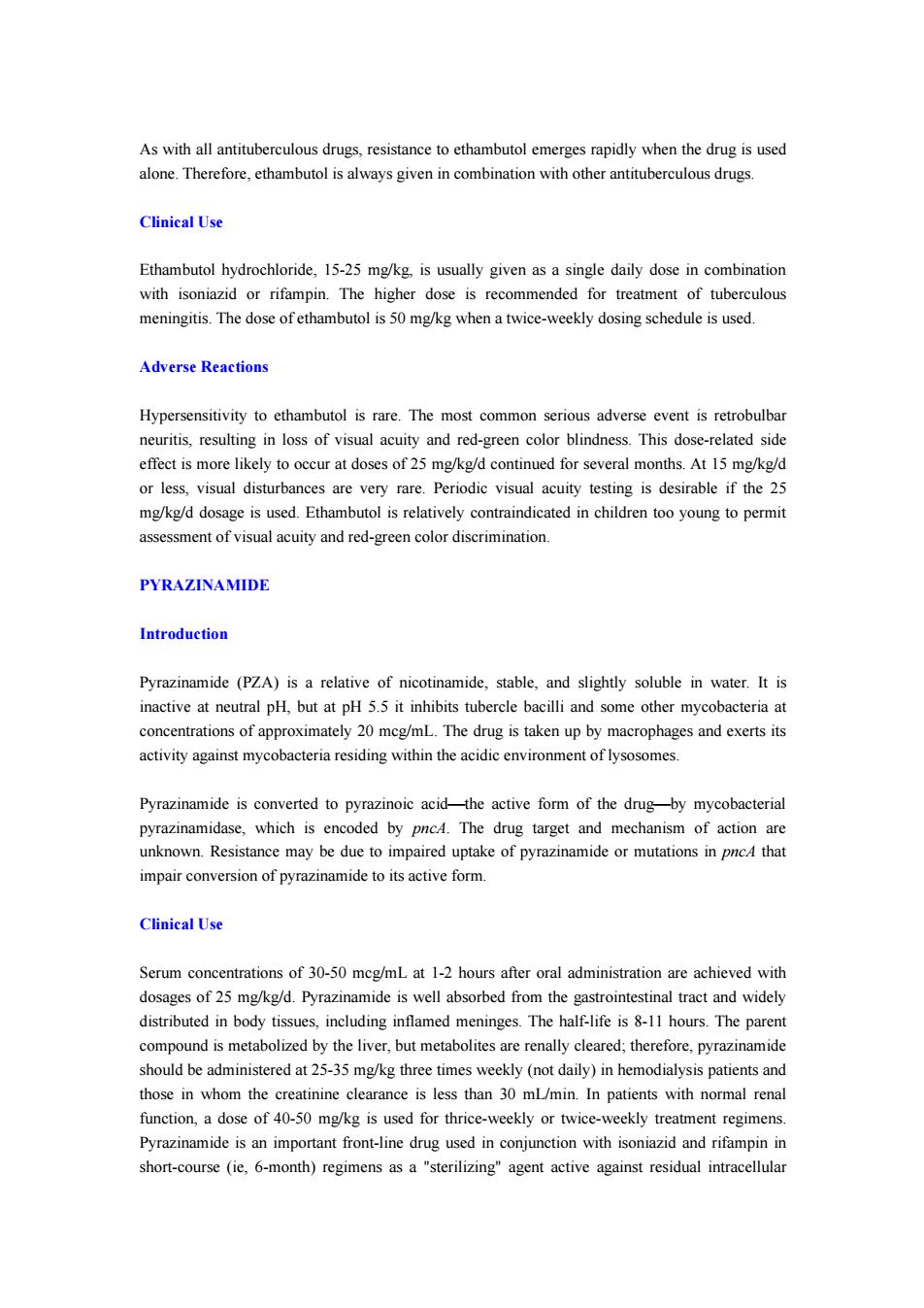正在加载图片...

As with all antituberculous drugs,resistance to ethambutol emerges rapidly when the drug is used alone.Therefore,ethambutol is always given in combination with other antituberculous drugs. Clinical Use Ethambutol hydrochloride,15-25 mg/kg,is usually given as a single daily dose in combination with isoniazid or rifampin.The higher dose is recommended for treatment of tuberculous meningitis.The dose of ethambutol is 50 mg/kg when a twice-weekly dosing schedule is used. Adverse Reactions Hypersensitivity to ethambutol is rare.The most common serious adverse event is retrobulbar neuritis,resulting in loss of visual acuity and red-green color blindness.This dose-related side effect is more likely to occur at doses of 25 mg/kg/d continued for several months.At 15 mg/kg/d or less,visual disturbances are very rare.Periodic visual acuity testing is desirable if the 25 mg/kg/d dosage is used.Ethambutol is relatively contraindicated in children too young to permit assessment of visual acuity and red-green color discrimination. PYRAZINAMIDE Introduction Pyrazinamide (PZA)is a relative of nicotinamide,stable,and slightly soluble in water.It is inactive at neutral pH,but at pH 5.5 it inhibits tubercle bacilli and some other mycobacteria at concentrations of approximately 20 mcg/mL.The drug is taken up by macrophages and exerts its activity against mycobacteria residing within the acidic environment of lysosomes. Pyrazinamide is converted to pyrazinoic acid-the active form of the drug-by mycobacterial pyrazinamidase,which is encoded by pnc4.The drug target and mechanism of action are unknown.Resistance may be due to impaired uptake of pyrazinamide or mutations in pncA4 that impair conversion of pyrazinamide to its active form. Clinical Use Serum concentrations of 30-50 mcg/mL at 1-2 hours after oral administration are achieved with dosages of 25 mg/kg/d.Pyrazinamide is well absorbed from the gastrointestinal tract and widely distributed in body tissues,including inflamed meninges.The half-life is 8-11 hours.The parent compound is metabolized by the liver,but metabolites are renally cleared;therefore,pyrazinamide should be administered at 25-35 mg/kg three times weekly(not daily)in hemodialysis patients and those in whom the creatinine clearance is less than 30 mL/min.In patients with normal renal function,a dose of 40-50 mg/kg is used for thrice-weekly or twice-weekly treatment regimens. Pyrazinamide is an important front-line drug used in conjunction with isoniazid and rifampin in short-course (ie,6-month)regimens as a "sterilizing"agent active against residual intracellularAs with all antituberculous drugs, resistance to ethambutol emerges rapidly when the drug is used alone. Therefore, ethambutol is always given in combination with other antituberculous drugs. Clinical Use Ethambutol hydrochloride, 15-25 mg/kg, is usually given as a single daily dose in combination with isoniazid or rifampin. The higher dose is recommended for treatment of tuberculous meningitis. The dose of ethambutol is 50 mg/kg when a twice-weekly dosing schedule is used. Adverse Reactions Hypersensitivity to ethambutol is rare. The most common serious adverse event is retrobulbar neuritis, resulting in loss of visual acuity and red-green color blindness. This dose-related side effect is more likely to occur at doses of 25 mg/kg/d continued for several months. At 15 mg/kg/d or less, visual disturbances are very rare. Periodic visual acuity testing is desirable if the 25 mg/kg/d dosage is used. Ethambutol is relatively contraindicated in children too young to permit assessment of visual acuity and red-green color discrimination. PYRAZINAMIDE Introduction Pyrazinamide (PZA) is a relative of nicotinamide, stable, and slightly soluble in water. It is inactive at neutral pH, but at pH 5.5 it inhibits tubercle bacilli and some other mycobacteria at concentrations of approximately 20 mcg/mL. The drug is taken up by macrophages and exerts its activity against mycobacteria residing within the acidic environment of lysosomes. Pyrazinamide is converted to pyrazinoic acidthe active form of the drugby mycobacterial pyrazinamidase, which is encoded by pncA. The drug target and mechanism of action are unknown. Resistance may be due to impaired uptake of pyrazinamide or mutations in pncA that impair conversion of pyrazinamide to its active form. Clinical Use Serum concentrations of 30-50 mcg/mL at 1-2 hours after oral administration are achieved with dosages of 25 mg/kg/d. Pyrazinamide is well absorbed from the gastrointestinal tract and widely distributed in body tissues, including inflamed meninges. The half-life is 8-11 hours. The parent compound is metabolized by the liver, but metabolites are renally cleared; therefore, pyrazinamide should be administered at 25-35 mg/kg three times weekly (not daily) in hemodialysis patients and those in whom the creatinine clearance is less than 30 mL/min. In patients with normal renal function, a dose of 40-50 mg/kg is used for thrice-weekly or twice-weekly treatment regimens. Pyrazinamide is an important front-line drug used in conjunction with isoniazid and rifampin in short-course (ie, 6-month) regimens as a "sterilizing" agent active against residual intracellular